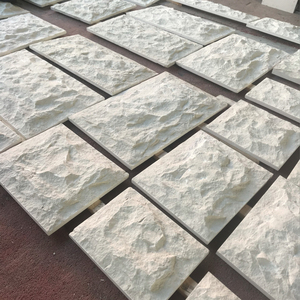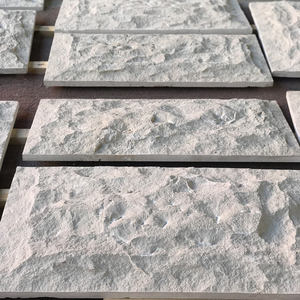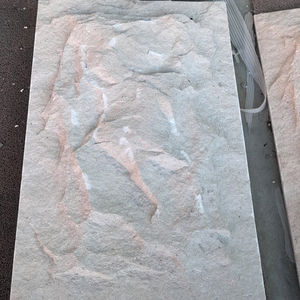(90257 products available)









































































































































































Limestone is a sedimentary rock that consists of over 50% calcite. It is available in different forms and types. Here is a detailed description of the various types of limestone and their uses.
Chalk
Chalk is a type of limestone that is white in color. It is formed from the skeletons of tiny marine creatures known as coccolithophores. Chalk is found in the ground and cliffs of North West Europe, especially in England. It is also used as a material for writing and drawing.
Coquina
Coquina is a type of limestone made from shells and coral debris cemented together. It is often found in coastal areas and can be identified by its shelly appearance. Coquina is a soft stone that is easily worked but lacks the durability of other limestones.
Fossiliferous Limestone
This limestone contains fossils of marine organisms like corals, shells, and algae. The fossils are visible to the naked eye. Fossiliferous limestone is evidence of the sediments that formed it, which were rich in marine life.
Oolitic Limestone
Oolitic limestone is a type of limestone composed of small, round particles called ooids. The ooids are formed from calcium carbonate that circulates in water. These particles are cemented together to form oolitic limestone. The water has to be warm and shallow for ooids to form. Oolitic limestone is found in areas like the British Isles and the USA. It is also used for building and making lime.
Purbeck Limestone
This type of limestone is mainly found in the Isle of Purbeck. It is a fossiliferous limestone with layers of chalky limestone and clay. Purbeck limestone is used to make buildings and monuments. It is also used to make lime products.
Travertine
Travertine is a metamorphic rock that is formed by the precipitation of calcium carbonate in hot springs and caves. It is a porous type of limestone with holes and cracks. Travertine is used for flooring, countertops, and other architectural details because of its beautiful appearance. It is also classified into Spanish, Mexican, and Roman travertine, based on where it is found.
Marble
Marble is a metamorphic rock that forms when limestone undergoes extreme heat and pressure. It is composed of interlocking crystals of calcite. Marble is highly valued for its beauty and is used in sculptures, and high-end flooring. It can also be white, black, pink, or green, based on its mineral content.
Limestone is a versatile rock with many industrial applications. It is used in the production of soda ash, lime, cement, and glass. These applications make limestone essential in construction projects and other industrial activities. Here are some features and functions of limestone:
Building and Construction
Limestone is widely used in construction because it is strong and durable. When properly cut and dressed, it can be used to construct walls, foundations, and other structures. Buildings made of limestone can last for a long time.
Cement production
Limestone is an important raw material in the production of cement. Cement is widely used in construction projects such as building houses, bridges, and roads. The high calcium content of limestone makes it suitable for cement production.
Soil Stabilization
Calcium carbonate, a product of limestone, is used in soil stabilization. It is effective in stabilizing clay soils and improving their load-bearing capacity. This is important in construction projects like roads and railways.
Lime production
Limestone is heated in a kiln to produce lime (quicklime). Lime has many applications in construction, including water treatment, metallurgy, and paper production. Lime is also used to produce hydrated lime, which is used to improve the quality of soil in construction.
Crushed Limestone
Limestone is crushed into small pieces and is used as a base material for roads, driveways, and pathways. It provides a stable base because it is compactable. Crushed limestone is also used for decor in gardens and landscapes.
Aggregate
Limestone is mined and crushed into small pieces. It is used as an aggregate in the construction of concrete and asphalt. Its availability makes it a good material for roads and airstrips. Limestone aggregate provides a strong and stable surface for vehicles and pedestrians.
Architectural Elements
As mentioned earlier, limestone is easy to work with. It is used to make architectural elements like window sills, columns, and door frames. Its aesthetic appeal improves the appearance of buildings and structures.
Environmental Applications
Limestone products are used in the construction of dams and levees. They help to control flooding and ensure water is stored. Limestone is also used to make locks and canals for ships and boats. It is an important product in water engineering.
Limestone is a versatile rock with numerous applications across various industries. Here are some of the key usage scenarios for limestone:
Construction Industry
Limestone is widely used in construction due to its abundance and ease of extraction. It serves as a foundational building block for many structures. Its historical significance and aesthetic appeal make it a popular choice for enduring landmarks and modern architectural designs. Additionally, limestone's role as a decorative element enhances both the exterior and interior of spaces. Its practicality ensures that it remains a favored material in construction.
Cement and Concrete Production
Limestone is a key ingredient in the production of cement, which is essential for concrete construction. The calcination process produces lime, which is used in various applications, including soil stabilization and water treatment.
Metallurgical Industry
Limestone is used as a flux in the smelting of iron and steel production. It helps remove impurities from the molten metal.
Agriculture
Crushed limestone, known as aglime or agricultural lime, is used to neutralize acidic soils and improve crop yields. It provides essential calcium to plants.
Environmental Applications
Lime from limestone is used in water treatment plants to remove impurities and soften water. It helps in the sedimentation process. Limestone is also used to neutralize acidic waters in rivers and lakes, restoring ecosystems. It is applied to landfills to manage and neutralize leachate.
Energy Production
Limestone is used in flue gas desulfurization systems in coal-fired power plants to reduce sulfur dioxide emissions. The reaction between limestone and SO2 forms gypsum, which can be sold as a byproduct.
Interior and Exterior Design
Limestone flooring, countertops, and fireplaces are popular in residential and commercial spaces. Its beauty and durability make it a desirable choice for architects and designers. Its non-slip surface and easy maintenance make it suitable for high-traffic areas. It is also used to create elegant and timeless kitchen and bathroom countertops.
Historical and Modern Architecture
Limestone's workability allows for intricate carvings and designs on historical and modern buildings. Its strength ensures longevity in architectural applications.
Art and Sculpture
Due to its softness, limestone is a favored choice for sculptors. It allows for detailed work and varies from fine-grained to coarse-grained textures.
When choosing limestone for sale, consider the factors below:
Color and appearance
Limestone colors are different. Some popular options include gray, cream, beige, yellow, pink and blue. These are the primary colors, but there are many more shades and hues. Therefore, the color of the limestone should match the color of the home or the intended design.
The finish also affects appearance. There are many options, such as honed, polished, brushed or bush hammered. Each option has a unique look, so choose the finish that complements the design.
Functionality
It's important to consider how limestone will be used. For example, some options are great for outdoor flooring but not for indoor flooring. Others are good for kitchen countertops but not for pool coping. As a result, always choose limestone based on its intended use.
Quality
It's also important to choose quality limestone. First, check if the supplier has provided a certificate of authenticity. Then, check the limestone's appearance - it should not have visible defects like cracks, spots or holes. If possible, get a sample to ensure the quality is intact.
Workability
Limestone is generally easy to work with, but some options are easier than others. For example, fossil beige limestone is easy to cut and shape. On the other hand, some options require specialized tools. As a result, it's important to choose limestone based on the level of expertise of the contractor or the tools available.
Maintenance
Limestone is beautiful, but it requires a lot of care and attention to maintain its appearance. For this reason, always choose limestone based on the amount of time and effort available for maintenance. If more time and effort are available, choose a high-quality option. On the other hand, if less time is available, choose a more durable and high-maintenance option.
Budget
The price of limestone varies depending on the quality, type and size. As a result, always choose limestone that is within the budget. This ensures that the project runs smoothly without financial hitches.
Q1: What are the different types of limestone?
A1: Limestone is classified into three main types: sedimentary, metamorphic, and igneous.
Q2: Is limestone the same as marble?
A2: Limestone and marble are not the same, but they are related. As mentioned earlier, limestone can be transformed into marble through metamorphic processes.
Q3: What are the two main uses of limestone?
A3: Limestone is used in construction and as a raw material for various industries, such as agriculture and chemical manufacturing.
Q4: What is the difference between chalk and limestone?
A4: Chalk is a type of limestone, specifically a soft, white limestone composed mainly of the microscopic skeletons of marine organisms.
Q5: What is the difference between limestone and granite?
The web search volume for the keyword "limestone" in the homeprove category shows a stable interest with an average monthly web search volume of 74,000. Over the past year, the overall web search volume remained unchanged, with a notable 22% increase observed in the last three months. The 12-month data reveals a pattern of fluctuating interest, with peaks reaching up to 90,500 web searches and valleys dipping to 60,500 web searches.
Analyzing the detailed monthly trends for "limestone," we notice that the web search volume peaked during the spring months of March, April, and May 2024, each hitting 90,500 web searches. Conversely, the lowest web search volumes were recorded in the winter and late summer months, specifically in January, August, and September 2024, each at 60,500 web searches. This pattern suggests seasonal variations, where interest in limestone likely spikes during specific times of the year, possibly aligned with construction or renovation cycles that are influenced by weather conditions.
The observed fluctuations and seasonal trends in web search volume for "limestone" indicate a cyclic interest that could be tied to industry-specific activities and seasonal projects. The data highlights periods of heightened demand, which could be crucial for businesses and marketers within the homeprove sector to align their strategies. Understanding these trends helps in forecasting future demands and planning marketing or promotional activities accordingly.